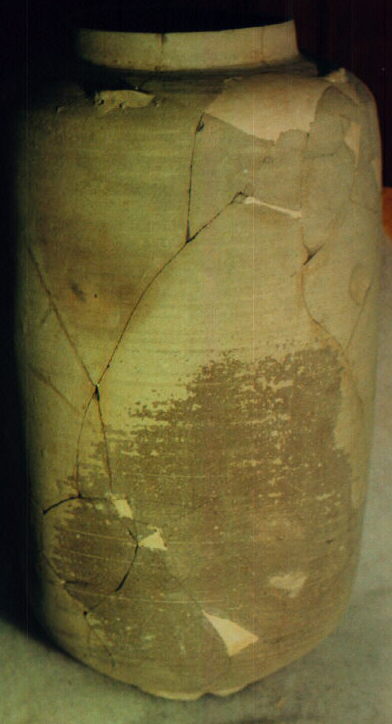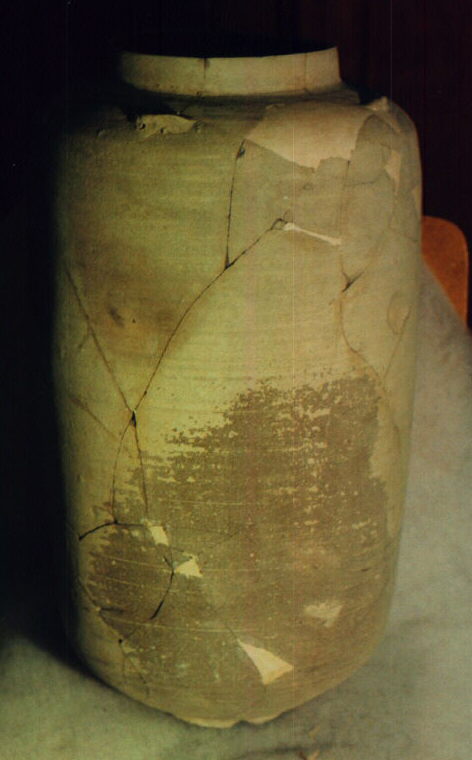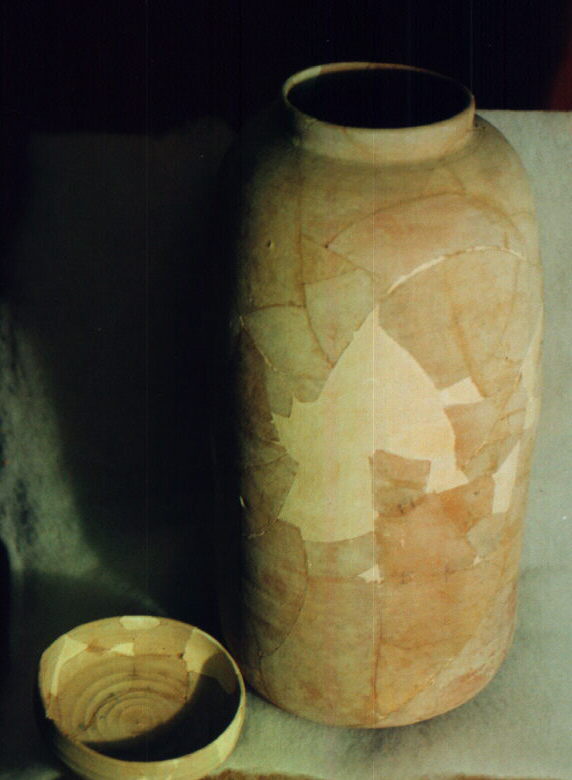* Dead Sea Scrolls and Pottery at Qumran *

Store Jar, really designed to hold a Scroll ?
The Dead Sea Provenience Project concerns the Qumran Pottery
found in association with the site and the caves where the Dead
Sea Scrolls were found. The pottery was submitted to neutron
activation analysis (NAA) to learn where the pottery was made.
The present Homepage concerns a collaborative project
between:
- The Hebrew University (Jan Gunneweg Ph.D., Archaeometrist,
Archaeologist)
- The Technical University of Budapest (Marta Balla Ph.D.,
Geologist, Archaeologist)
- The Ecole Biblique (Jean-Baptiste Humbert Ph.D.,
Archaeologist)
After hundreds of publications concerning the restoration and
the textual exegesis of the Qumran Dead Sea Scrolls, it seemed to
us a logical step to study the Qumran storage jars, the cups,
the dishes and other ceramic containers which have been unearthed
at the Qumran Complex itself and in its surrounding caves in
order to learn:
* W H E R E * all these vessels were
manufactured to establish the cultural interactions with peaple
near to or remote from Qumran ?
Of course, it will not be easy to receive an answer to the
provenience of all the vessels--otherwise one has to analyze
every piece of ceramic found. It is, however, hoped that a
representative sampling will see to it that one can reach a
conclusion which is based on sound statistics.

Sampling one of the Qumran storage jars
As is shown in Gunneweg's Homepage of his branch of work at
the Hebrew University (a link to be found at the bottom of this
page), it is, today, possible to trace pottery through its
chemical composition to the pottery manufacture center where it
was made.
The NAA technique is based on the assumption that every clay
source on Earth has its own chemical composition and pottery made
thereof can be recognized and told apart.
Once the abundance of each chemical element is known, one can
compare each analysis with that of ceramics classified by the
archaeologists as 'local' . Kiln wasters (misfired pottery lumps)
are site specific.
A chemical match between a pottery vessel and a waster means that
one has found the place where that pottery was made.
The analytical procedure as well some of the results of
this study have been recorded by the Discovery Channel on a
Video casette of 52 minutes, entitled: Dead Sea Scrolls,
Voices from the Desert by KBYU/Scandinature Films,
USA
Also the BBC made a documentary entitled The Secrets of
the Dead Sea Scrolls , by Kick Productions
The second documentary made by the Discovery Channel--a
follow-up--will be aired in the beginning of 2001
We have analyzed by NAA about 200 samples of various
styles of vessels found at Qumran. For most of the pottery, we
have not only obtained a chemical "Fingerprint" but a match with
that of a specific site.
We expect to learn:
1. Is there a difference between the pottery found in the
Qumran complex and that from the caves?
2. Was all or part of the sampled pottery locally made in
Qumran ? This will, for example, hopefully provide an answer to
the question whether the people of Qumran--perhaps the
Essenes--came with their pottery on them from elsewhere or
whether they manufactured their own on the spot in the Qumran
Complex.
3. If the jars and other utensils were brought in from
Jerusalem, Bethlehem, Jericho, Masada, Engedi (or from any other
site for which we have NAA data), we will hopefully be able to
match the chemical compositions of the analyzed Qumran pottery
with those of ancient pottery stored on our data banks.
4. Is it possible to "see" a difference in the pottery
manufacture-technology when the analyses would point to
different chemical compositions of the vessels. By the means of
mineralogical studies, one may then see whether these differences
may be explained by potter's practices, such as the addition of
temper to the clay or by levigation. (e.g. by Petrography)
5. By analyzing the various styles of pottery found at
Qumran and similar ones from other sites, nearby and further
away, will we be able to trace the interactions that certainly
took place between the Essenes in Qumran and other
populations so that the site of Qumran will get its long deserved
archaeological link with other sites in the region.



 Storage jars sometimes called "Scroll Jars"
Storage jars sometimes called "Scroll Jars"
To recapitulate, one has to determine the chemical composition of
pottery and the match with others, after which a re-newed
stylistical study must be performed to check whether the
differences in chemistry also correspond to those in the
different stylistic "look" of the vessels so that also the
stylistic studies will keep their value in archaeology.

Did this kiln fire all the pottery? Dead Sea on the
background
Today, there are highly scientific techniques at our disposal.
The Khirbet Qumran material cultural remains can be studied to
extract the utmost important information to interpret Qumran
archaeologically and historically.
J-B Humbert of the Ecole Biblique of Jerusalem and Jan
Gunneweg of the Hebrew University are the co-editors of a
Publication of the Archaeology of Qumran. The volume will appear
in a joint publication of the Presses Universitaires de Fribourg,
Suisse and the ecole biblique of Jerusalem.
The planned volume will be consecrated to the following
subjects:
- Petrographic results on scroll jars and some aspects of the
geology of Qumran, by Jacek Michniewicz Ph.D. (Poznan,
Poland)
- Qumran Cemetery Anthropology, by Susan Sheridan Ph.D. Notre
Dame University (USA)
- Carbon-14 Bone tests on a collection of bone found at the
Qumran cemetery, by Susan Sheridan Ph.D. and Kaare Rasmussen
Ph.D. (Royal Museum Laboratories (Denmark)
- X-Ray Diffraction and C14 tests on the plaster of Qumran,
by Katharine Galore (Hebrew University)
- Controversial methods of Provenience analyses obtained by
Thermoluminescence and Magnetic Susceptibility viz-a-viz Neutron
Activation, by Jan Gunneweg and Kaare Rasmussen
- NAA results on various Common Ware Pottery from the
Settlement and the Caves at Qumran, by Jan Gunneweg and Marta
Balla Ph.D. of the Nuclear Facility at the Technical University
of Budapest, Hungary
- A textile analysis of Qumran linen and wool I have send to
the Warrington lab in the UK where Dr. M. Pantos will establish
the used pigments.
- A metallurgical analysis of a metallic conglomerat of
Qumran finds by Noel Lacoudre of the Metal Research EDF
Laboratories, Paris.
Who wants to help us out in co-funding this
interesting project?
As everything else in life, there is a price for every piece
of information extracted from scientific research so that mankind
may enjoy the roots of its past and learn from that to furnish
the private lives of its individuals with a deeper insight into
the importance of each one's existence.
The Dorot Foundation provided the funds (6,000 U.S. Dollars)
for the pilot study of the first 100 analyses
However, more money will have to be set aside in order to pay
for the rest of the analyses and to enlarge this pilot study into
full fledged scientific Pottery_Provenience_Project. With some
good planning, the running of the samples and the interpretation
of the NAA results will take less time than the slow deciphering
process of the Scrolls.
In case you want to help, please, send me
an e-mail or a letter wherein you express the wish to contribute.
Please contact:
Jan
Gunneweg's Email
And in case you are curious to know what I do when I am not
busy with the Qumran pottery, please, click here for an
interesting Archaeological Excursion in Archaeometry, see Archaeom
etry Homepage or have a look at
our home at Yemin Moshe in Jerusalem
Correspondence address:
- Dr. Jan Gunneweg
- Institute of Archaeology
- The Hebrew University
- 91905 Jerusalem
- Israel
- Tel: 972-2-6234830 (or leave a message)
- Fax: 972-2-6234830
Copyright: Jan Gunneweg, Hebrew University, December, 2000







